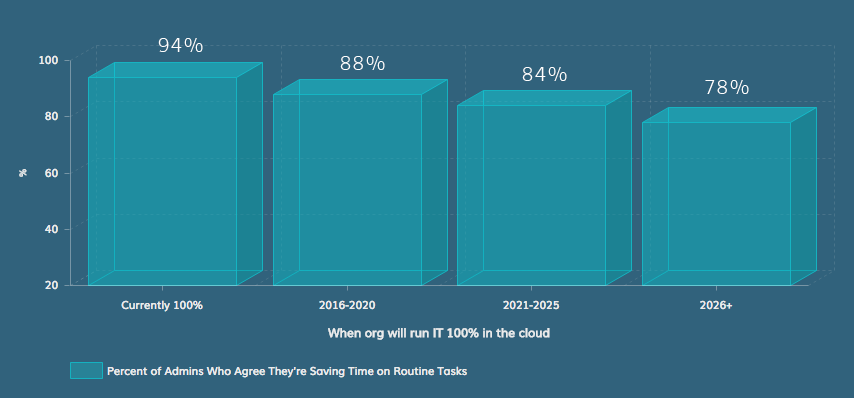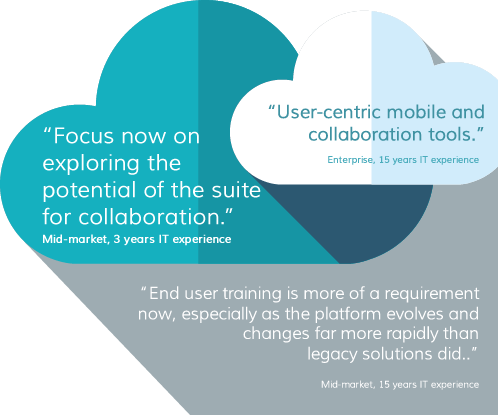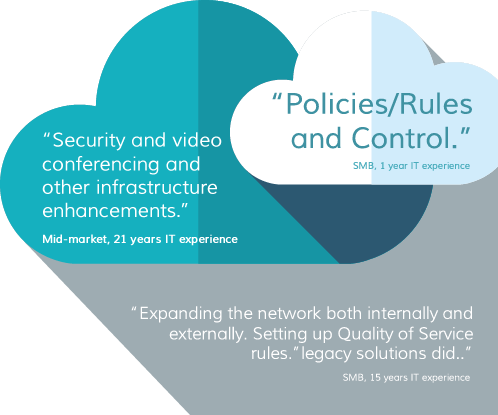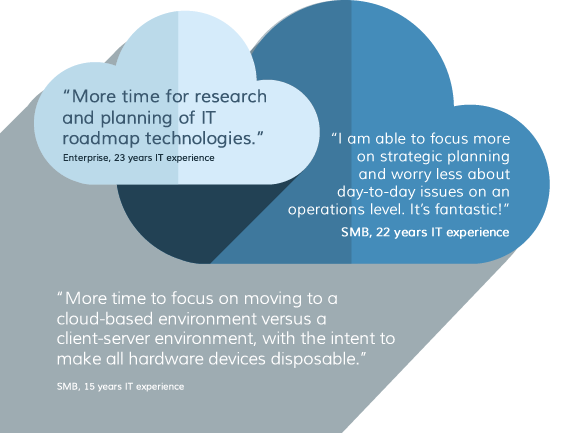The Role of IT: How the Shift to the Cloud is Creating Agents of Innovation
August 11, 2015
8 minute read

We continue our TRENDS IN CLOUD IT series by taking a look at the people behind the shift to the cloud: the admins. Our previous posts have helped us understand the factors affecting cloud adoption and provided insight into the customer bases of Google and Microsoft.
We’re entering a new era of enterprise technology. The cloud is changing the way all employees work and those most affected will be IT professionals, whose roles and responsibilities are entering new territory.
For many years, IT admins have been subjected to job descriptions that included words like “upkeep” and “maintenance.” Admins are often viewed as enforcers instead of enablers. Yet, the emergence of cloud IT is altering perceptions by freeing up valuable time that cloud IT admins are using to become proactive decision makers in their organization, rather than reactive troubleshooters.
Our data, collected from more than 1,500 cloud IT professionals, has helped us paint a picture of the modern cloud IT admin.
AVERAGE CLOUD IT ADMIN

Many of the results weren’t what we expected. We expected Google Apps admins to have fewer years of experience than Office 365 admins because Google Apps organizations are generally smaller and founded more recently. Yet regardless of several variables (size of the organization, organization age, position on the cloud adoption curve), Google Apps and Office 365 admins have nearly identical years of experience.
Overall, cloud IT admins across platforms are very similar to one another.
- On average, a Google Apps admin has the same years experience as an Office 365 admin.
- On average, an admin for a large enterprise organization has the same number of certifications as an IT admin for a small business.
Dissecting our data against a number of variables revealed a single powerful common denominator: cloud adoption. There’s a clear correlation between how much time cloud IT admins are saving on routine tasks and where they are on the cloud adoption curve.
Cloud IT admins who work for organizations that run more of their IT in the cloud spend less time on common IT tasks. Instead, they’re focusing more on strategic, non-routine tasks that add value to their organization.
Key Takeaways
- Cloud IT admins are substituting conventional IT work with a wide variety of strategic and proactive tasks (e.g. improving security, end-user training, application integrations).

- Cloud adoption is a powerful common denominator: Admins working for organizations running more of their IT in the cloud spend less time on mundane tasks.

- The shift to cloud IT will have an impact on all admins; the question is not if, but when. Cloud IT admins whose organizations are quicker to move to the cloud will notice a change in job responsibilities much sooner.

- Cloud IT admins, regardless of cloud office system (Google Apps or Office 365), are remarkably similar to one another. However, Office 365 admins are more likely to be certified in their respective platform than Google Apps admins.

- Office 365 and Google Apps admins are similarly involved in their companies’ migrations to cloud office systems, with the majority of migrations happening in-house (67% vs. 68%).

- Office 365 admins are managing multiple cloud office systems more often than Google Apps admins (47% vs. 24%).

What Tasks Are Cloud IT Admins Spending Less Time On?
Since moving to Google Apps or Office 365, cloud IT admins overwhelmingly agree that they spend less time on certain routine tasks.

Are Early Cloud IT Adopters Saving More Time?

Cloud IT admins whose organizations are slower to move 100% of their IT to the cloud are spending more time on common IT tasks.![]()
—
A staggering 94% of admins that use cloud office systems and currently run 100% of their IT in the cloud agree they are saving time on everyday IT tasks. In comparison, 78% of admins who expect their organizations to take 10-plus years to fully adopt the cloud can say the same.
On average, the quickest cloud adopters are:
- Spending 25% less time on scheduled maintenance tasks
- Spending 23% less time on unscheduled maintenance tasks
- Spending 20% less time on storage and quota management
- Spending 27% less time on data recovery
- Spending 21% less time on upgrades
A great example of how cloud IT admins are using the cloud to reduce their workload comes from conversations I’ve had with many Office 365 admins. They’re actually telling their users to use Outlook on the web when issues arise with the desktop client. This results in an “aha” moment for these admins, confirming to them that if they can just get their users to work in the cloud, helpdesk tickets will begin to decline.
How IT is Helping to Create Strategic Value
We received more than 120 free form responses from cloud IT admins about how they’re spending their newfound time since implementing a cloud office system. After reviewing the responses, six common themes emerged:
- Improving Collaboration and End-user Training
- Application Integration and Development
- Infrastructure Improvements and Security Enhancements
- Strategic Planning for Cloud Success
- Reporting, Data Analysis and Long-term Projects
- Professional Development and Non-routine IT Work
Improving Collaboration and End-user Training
 Cloud IT admins are pushing for more collaboration–both inside and outside their organization. Simply emailing with team members is no longer enough: IT admins want to learn how they can use cloud office systems to increase their organization’s collaboration capabilities with features like real-time co-editing and document sharing–all while keeping sensitive data safe.
Cloud IT admins are pushing for more collaboration–both inside and outside their organization. Simply emailing with team members is no longer enough: IT admins want to learn how they can use cloud office systems to increase their organization’s collaboration capabilities with features like real-time co-editing and document sharing–all while keeping sensitive data safe.
For many end users, a recent move to the cloud may be overwhelming at first. Cloud IT admins are replacing time spent on things like data recovery and upgrades with training and end-user education. Depending on your organization’s employee base, training might be unnecessary, but for most organizations it may be one of the most vital aspects of the shift to the cloud.
Application Integration and Development

With an increasing abundance of APIs, cloud IT admins are building deeply integrated cloud platforms. The cloud enables data to flow seamlessly from application to application, making end users–and organizations as a whole–more productive. Expanding the capabilities of cloud office systems through integrations with other cloud applications is a main focus for cloud IT admins in 2015. The end goal: enhance employee productivity and access.
Developers working for smaller organizations often serve as accidental admins, helping to keep email servers up or maintaining their infrastructure; now, the cloud is enabling them to spend more time on what they love: application development.
Infrastructure Improvements and Security Enhancements

Security remains a priority among IT professionals. Data is moving off of devices and on-premises servers and heading to the cloud. Cloud IT admins are taking the time to learn and setup new tools, rules and processes to secure their cloud environments. Whether it’s through infrastructure improvements or automated compliance policies, security enhancements are on the minds of many cloud IT admins in 2015.
Strategic Planning for Cloud Success
 As our data has shown, the majority of organizations are only just beginning their shift to the cloud. Cloud IT admins who are leading their organization’s shift to the cloud are strategically mapping out their cloud-based future. This is especially true for large organizations that literally have millions–even billions–of dollars riding on a successful transition.
As our data has shown, the majority of organizations are only just beginning their shift to the cloud. Cloud IT admins who are leading their organization’s shift to the cloud are strategically mapping out their cloud-based future. This is especially true for large organizations that literally have millions–even billions–of dollars riding on a successful transition.
Reporting, Data Analysis and Long-term Projects

Cloud IT admins are taking advantage of customized reporting tools that help them cut costs and gain insights into which cloud applications are being used effectively.
Many admins spend small amounts of time on a wide variety of tasks, but the shift the cloud is enabling them to dedicate more time to long-term projects that they’ve been putting off. Whether it’s focusing on developing a bring your own device (BYOD) policy or building out the company intranet, cloud IT admins are have more time to take on special projects.
Professional Development and Non-routine IT Work
 Research and training isn’t just for end users; admins want to advance their careers as well. According to a recent CompTIA survey, “66% of employers consider IT certifications to be very valuable — a dramatic increase from the 30% in 2011.” By spending more time on professional development, cloud IT admins benefit both themselves and their organizations.
Research and training isn’t just for end users; admins want to advance their careers as well. According to a recent CompTIA survey, “66% of employers consider IT certifications to be very valuable — a dramatic increase from the 30% in 2011.” By spending more time on professional development, cloud IT admins benefit both themselves and their organizations.
One of the things that stood out most from the free form responses is how many distractions admins have to deal with. Several respondents said the shift to the cloud is finally giving them the opportunity to focus on the core areas of their jobs.
How Cloud Adoption is Impacting Cloud Application Usage

Cloud IT admins will need to gain the skills (and tools) necessary to manage a wide variety of cloud applications, regardless of where their organization sits on the adoption curve. As the data above illustrations, cloud application usage is on the rise.
—
Because of the rise in cloud application usage, cloud IT professionals will become more influential within their organization, and as a result, organizations whose IT teams are well-skilled in end-user enablement will have an advantage over their competition.
The Changing Role of IT
With cloud adoption set to rise in the coming years, cloud IT admins need to prepare themselves for the changes to come–especially as they become significant decision makers within their organizations. For some, these new roles are already taking effect, for others, change will come more gradually.
But for every IT admin, the cloud has the potential to expand their roles and reverse the “cost center” perception that IT departments often wear like a scarlet letter.
As a cloud IT admin, think about what you’ll be able to get done when you are no longer bogged down by mundane tasks. Would you enhance security? Increase collaboration? Get certified?
Every admin has a different agenda depending on the needs of their organization, but with more time, and less busy work, cloud IT admins have an opportunity to become agents of innovation for their organization and truly capitalize on their emerging role as enablers.
Next up in Trends in Cloud IT: The Channel’s Impact on the Shift to The Cloud
In our next Trends in Cloud IT post, we’ll explore what types of organizations and IT teams are likely to work with partners and how the partner effect is influencing things like migration and overall satisfaction with cloud office systems.





